ASUS X99-A Motherboard Review
by Ian Cutress on December 22, 2014 2:00 PM EST- Posted in
- Motherboards
- Intel
- Asus
- Haswell-E
- LGA2011-3
System Performance
Power Consumption
Power consumption was tested on the system while in a single MSI GTX 770 Lightning GPU configuration with a wall meter connected to the OCZ 1250W power supply. This power supply is Gold rated, and as I am in the UK on a 230-240 V supply, leads to ~75% efficiency > 50W, and 90%+ efficiency at 250W, suitable for both idle and multi-GPU loading. This method of power reading allows us to compare the power management of the UEFI and the board to supply components with power under load, and includes typical PSU losses due to efficiency. These are the real world values that consumers may expect from a typical system (minus the monitor) using this motherboard.
While this method for power measurement may not be ideal, and you feel these numbers are not representative due to the high wattage power supply being used (we use the same PSU to remain consistent over a series of reviews, and the fact that some boards on our test bed get tested with three or four high powered GPUs), the important point to take away is the relationship between the numbers. These boards are all under the same conditions, and thus the differences between them should be easy to spot.



It would seem that the X99 motherboards are filtering into several bands of peak load power usage, around 200W, 210-220W and 240W+. The ASUS fits into the low end of that middle band.
Windows 7 POST Time
Different motherboards have different POST sequences before an operating system is initialized. A lot of this is dependent on the board itself, and POST boot time is determined by the controllers on board (and the sequence of how those extras are organized). As part of our testing, we look at the POST Boot Time using a stopwatch. This is the time from pressing the ON button on the computer to when Windows 7 starts loading. (We discount Windows loading as it is highly variable given Windows specific features.)
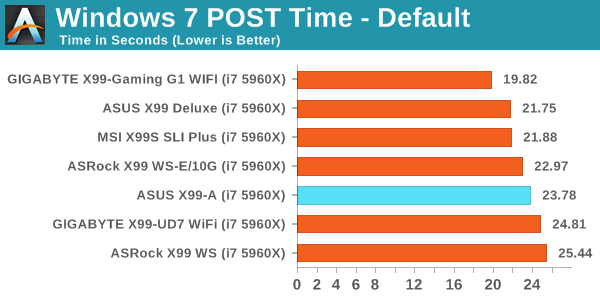
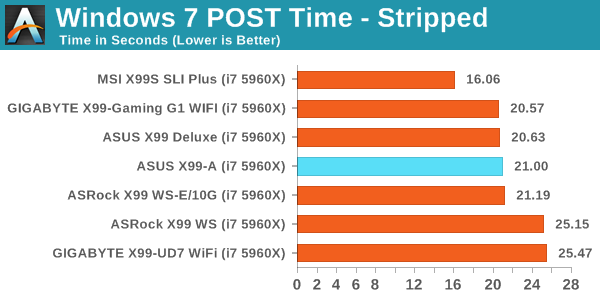
POST Times of all X99 motherboards are around the 20-25 second mark, and on the BIOS we used we saw almost 24 seconds.
Rightmark Audio Analyzer 6.2.5
Rightmark:AA indicates how well the sound system is built and isolated from electrical interference (either internally or externally). For this test we connect the Line Out to the Line In using a short six inch 3.5mm to 3.5mm high-quality jack, turn the OS speaker volume to 100%, and run the Rightmark default test suite at 192 kHz, 24-bit. The OS is tuned to 192 kHz/24-bit input and output, and the Line-In volume is adjusted until we have the best RMAA value in the mini-pretest. We look specifically at the Dynamic Range of the audio codec used on board, as well as the Total Harmonic Distortion + Noise.
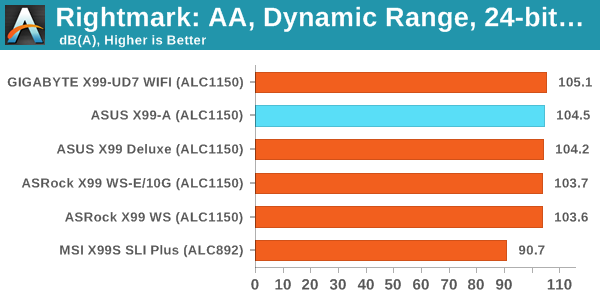

The X99-A performs extremely well in our audio testing, scoring some of the best results we have ever seen.
USB Backup
For this benchmark, we transfer a set size of files from the SSD to the USB drive using DiskBench, which monitors the time taken to transfer. The files transferred are a 1.52 GB set of 2867 files across 320 folders – 95% of these files are small typical website files, and the rest (90% of the size) are small 30 second HD videos. In an update to pre-Z87 testing, we also run MaxCPU to load up one of the threads during the test which improves general performance up to 15% by causing all the internal pathways to run at full speed.
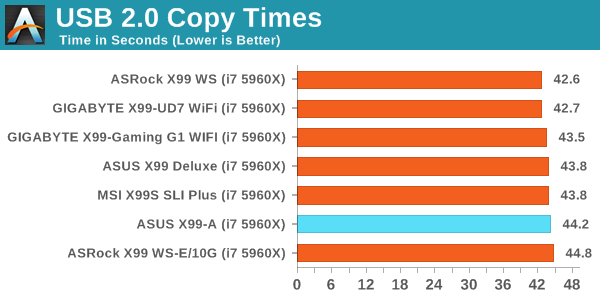
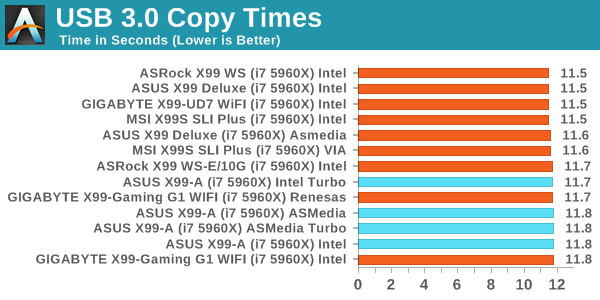
USB performance was on the low end compared to our other motherboards tested.
DPC Latency
Deferred Procedure Call latency is a way in which Windows handles interrupt servicing. In order to wait for a processor to acknowledge the request, the system will queue all interrupt requests by priority. Critical interrupts will be handled as soon as possible, whereas lesser priority requests such as audio will be further down the line. If the audio device requires data, it will have to wait until the request is processed before the buffer is filled.
If the device drivers of higher priority components in a system are poorly implemented, this can cause delays in request scheduling and process time. This can lead to an empty audio buffer and characteristic audible pauses, pops and clicks. The DPC latency checker measures how much time is taken processing DPCs from driver invocation. The lower the value will result in better audio transfer at smaller buffer sizes. Results are measured in microseconds.
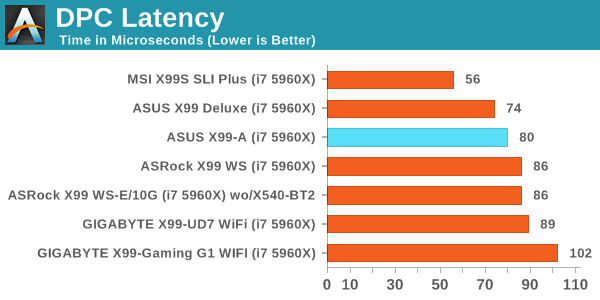
All X99 motherboards are aiming at the sub-100 microsecond category, and the X99-A fits in there with a score of 80.











37 Comments
View All Comments
Samus - Tuesday, December 23, 2014 - link
Probably an awesome board for $200, but I agree with the conclusion: just not worth it for $250+ when $300-$350 gets you a way nicer board. We're already talking supercar-class with the X99 platform as it is so why penny pinch when building a $1000+ PC. If you're building a Ferrari, build a Ferrari.ziphnor - Tuesday, December 23, 2014 - link
Just did a built with an X99-A myself. With the prices available to me the X99 Deluxe is ~60% more expensive than the X99-A and seems to only offer a lot of crap that i dont need in comparison? How does it make my desktop PC more "Ferrari" by having WiFi, extra ethernet ports or more storage options, especially when i have no need of them?SuperVeloce - Tuesday, December 23, 2014 - link
I agree. This is a spot on board for something like 5820k and single gpu setup.dcoca - Tuesday, December 23, 2014 - link
I disagree, it supports X16 X16 for sli and plus X8 for tri and solution: I have this board and with the Asus app it overclocked my cpu to 4.6 all cores stable.. and it had x4 for m.2 so that's great in the future... I picked it overs cause of the Asus name and features that I needed..dcoca - Tuesday, December 23, 2014 - link
That should of read AMD solution...ziphnor - Friday, December 26, 2014 - link
Out of curiosity, could you provide some details on that 4.6 OC? Is it "stable" or Prime95 stable, and what voltage did you need? I am on air, and have only managed 4.3@1.175V with my 5820k, and only in combination with setting a Turbo Boost TDP limit (otherwise i cannot run Prime95 succesfully)dcoca - Friday, January 9, 2015 - link
Sup sir, well the application did it's thing and increase the vcore to 1.3 and I ran prime95.. with that said I took it back to 4.4 cause the antech 650 wasn't cooling it to the level I want... I run simulations for a hobby of the universe so can't have the pc crash on me cause of heatR3MF - Tuesday, December 23, 2014 - link
agreed, what i did with the MSI X99 SLI-pluspaesan - Wednesday, December 24, 2014 - link
I did a build with this board for my brother and was able to overclock the 5820K to 4700 using the 5 way optimization. I used the Corsair H100i for cooling the cpu. This board is the best price point for those that do not need wifi, extra lan port and other extra features that are in the deluxe version. I agree with you that the deluxe version adds more features that a lot of people have no need for. I have a z87-pro board and never use the wifi.R3fug388 - Tuesday, December 23, 2014 - link
The bottom of the first page, where you mention the 4 USB 2.0 on the back panel. Is that a typo? Is it supposed to be USB 3.0?